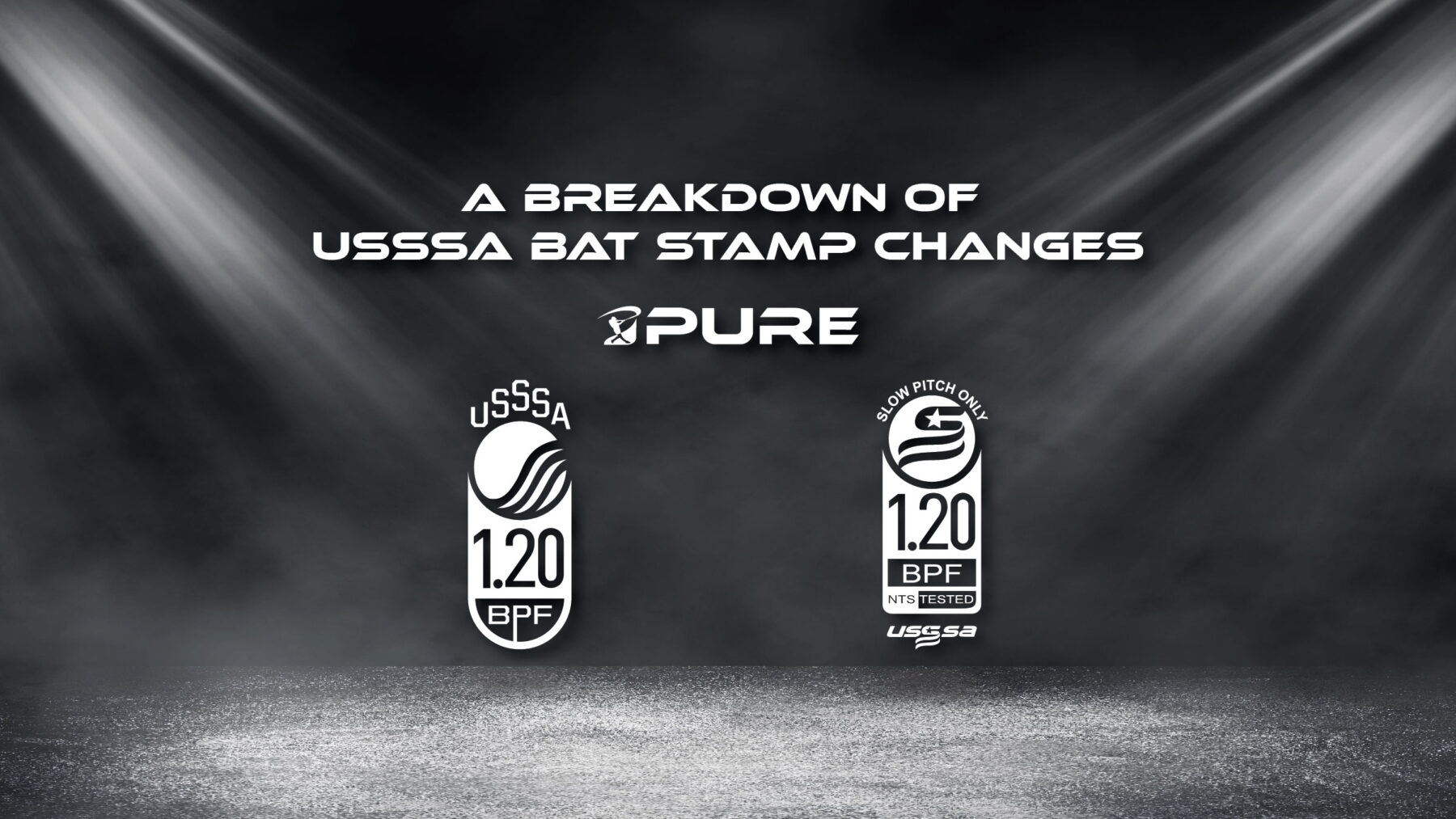Menu
- Mon - Fri : 8:00am - 5:00pm

Written by, Joshua Kusich – Pure Sports Rep
Over the last year, the slowpitch softball world had been inundated with countless announcements regarding changes to the USSSA bat stamp. This information seems to come in pieces and does not fully address the questions and concerns of all stakeholders in the softball community. For example, how do these changes impact the sanction you play in? How do these changes impact the player? How do the old stamp and new stamp bats compare? The intention of this research is to clear up these questions to help the average player make educated decisions regarding their 2021 bat choices.
In order to address these concerns, we must first gain a clear understanding of bat compression testing and the purpose of the stamps. Bat compression testing defines the amount of pressure required to compress the barrel of a softball bat. The compression reading translates to the rigidity or flexibility of the barrel. Historically, a higher compression reading depicts a more rigid barrel with a barrel wall that is inflexible. A bat with a lower compression reading means the barrel walls are more flexible and easier to compress. Rigid barrels have a lower trampoline effect while flexible barrels have a higher trampoline effect. The trampoline effect translates to the exit speed of a ball off the bat.
The stamp on the bat defines the failing compression rating of the bat. USSSA announced in early 2020 their intention to move to a new stamp with a higher compression rating. The bat market now consists of bats that are made with either the old stamp or the new stamp. The old stamp bats were made from 2012 to 2020 and meet the 220 compression testing standard. Beginning with 2021 models, USSSA is using the new 240 compression standard with the new NTS stamp. Please note manufacturers can still make bats to meet the 220 compression standard but they can no longer have the USSSA Stamp. To clarify this mess of information, the old stamp bats get “hotter” much quicker while the new stamp bats take more time to break-in, but last much longer. Testing has proven that there is no loss in performance between the two and many bat reviewers are now seeing that as well, such as the slowpitch bat bros.
Moving on to the important stuff, how does this change impact the sanction you play in? Each sanction can, and will, decide which bat stamps are approved for play within their organization. USSSA has announced they will accept both old stamp and new stamp bats in 2021 and moving forward. The availability of the old stamp bats will naturally diminish as bats break or fail compression. It is important to note the compression testing standards are also grandfathered in with each stamp. Therefore, old stamp bats will never have to test at a compression rating other than 220. In contrast, USSSA Conference has only approved the new 240 NTS stamped bats for sanctioned play.
More importantly, how do these stamp changes impact the players? Players should see minimal impact on their wallets based on the stamp change. Most sanctions have approved the usage of old stamp bats permanently. This means that most bats that you currently possess with the old stamp are legal if they pass compression. The only exception to this rule is with USSSA Conference. In Conference, teams are only allowed to use the new 240 NTS stamped bats. Naturally, this will force conference teams to purchase these new bats to play in 2021. For all the non-conference players, remember that the old stamp bats are no longer being produced by manufacturers. The old stamp bats currently on the market were likely produced in 2020, before the production cut-off hit. Once these bats are gone, they are likely gone forever!
So, given these changes to the stamp, what should the player expect regarding performance? Bats built to the old stamp standard are engineered to have a failing point of 220. These old stamp bats are designed to be hot out the wrapper. Typically, these bats take 50 or less swings to break-in and are engineered to hold compression around the 220 area. With the new 240 standard, manufacturers are forced to redesign and re-engineer bats to hold compression at a higher level. As a result, new stamp bats will feel stiffer out the wrapper. As noted previously, the compression rating translates to the trampoline effect of the bat. This higher compression bat will have noticeable differences in exits speed, distance, and sound. New stamp bats will be less hot out the wrapper in comparison to an old stamp bat and will take more swings to break-in. Keep in mind the new stamp bats are designed to retain a compression rating around 240. That means the new stamp bats will have a longer life as they will be able to withstand a greater amount of hits. Additionally, the more the new stamp bats are used, the “hotter” they will get! Do not hesitate to reach out to a Pure Rep for any questions or concerns regarding any of this information.
#SWINGPURE
Author
Joshua Kusich
Pure Sports Lead Rep
Josh Kusich is a Senior Operations Manager with over a decade of experience in project management, data analysis, process integration, and strategic planning. Josh specializes in process automation where he leverages data management tools and integration platforms to automate user tasks. Josh has an extensive academic background with bachelor’s degrees in Psychology and Business Analytics and a Master’s in Business Administration. He is a softball junkie with experience as a Lead Rep for Pure and as a tournament director for One Nation.

Pure is a leading manufacturer of Softball bats. Located in the Tampa Bay area, we are possibly the last company in softball that designs, assembles and paints our bats in the United States. We offer custom bats in quantities as few as one and can even black label bats for other companies. Contact us today to learn more. Read More…
Monday – Friday: 8:00am – 5:00pm